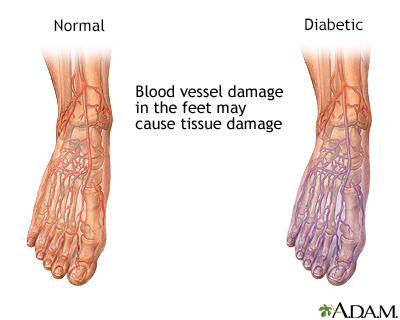| Step 11: Long-term complications |
Over time, poorly controlled diabetes can lead to a variety of serious health conditions, including heart disease, stroke, blindness, amputations, kidney disease, and nerve damage. Maintaining a healthy lifestyle and regular checkups are important throughout the life of a person with diabetes.
Heart disease and stroke
Over a period of years, diabetes can have a big impact on the heart and blood vessels. The problem needs to be taken seriously -- people with diabetes are at high risk of having a heart attack, stroke, or heart failure. According to the American Diabetes Association, these problems can occur at a younger age than they do in people without diabetes, and they are more deadly. In fact, heart disease and related complications are the leading cause of death in people with diabetes.

There are steps you can take to minimize the risks:
|
There are many ways to keep your heart healthy and reduce the risk of cardiovascular problems down the road. Talk to your doctor to learn what may benefit your situation. Recent research suggests that having a glycohemoglobin o fless than 7% may actually harm older patients and those with heart disease. This may indicated these patients may have some undetected low blood sugars. In this group, a glycohemoglobin of 7 - 7.5% is recommended.
Nerve damage (neuropathy)
Diabetes can damage the nerves and cause a complication called neuropathy. This generally begins as loss of sensation in the toes, and possibly fingers. Eventually, the neuropathy can move up your leg or arm. Symptoms to watch out for include:
- Tingling
- Weakness
- Burning sensations
- Loss of sensitivity to warmth or cold
- Numbness -- if the nerves are damaged enough, you may be unaware that a blister or minor wound has become infected.
- Abnormal blood pressure
- Problems with bowel and bladder control
- Impotence in men
- Bone deformity in foot ("Charcot foot")
You may even have a heart attack and not be able to feel any chest pain.
Poor circulation
People with diabetes are at risk for blood vessel injury, which may be severe enough to cause tissue damage in the legs and feet. If nerve damage is also a problem, then the person may not be aware of the injuries that have occurred in their legs or feet.
At that point, minor infections sometimes develop into deep tissue injuries that may even require surgery. In extreme cases, amputation of the foot or limb may be necessary. Good foot care is very important to prevent problems.

|
Kidney disease
The kidneys filter and clean blood. Not surprisingly, having too much glucose in the blood puts a strain on them. Over time, this can actually lead to kidney failure. When this happens, dialysis or a kidney transplant may be needed.

|
Eye problems
Diabetes is the leading cause of blindness in adults. The most common eye disorder in diabetes is retinopathy. This condition is caused by the excessive amount of glucose in the bloodstream, which weakens and damages the blood vessels. A weakened blood vessel may bulge out (aneurysm). The blood vessel may even rupture, leaking blood and fluid into the surrounding tissues (hemorrhage.) Either of these can cause vision problems. People with diabetes are also at higher risk for developing cataracts and certain types of glaucoma.

|
Other possible complications
- Gum disease
- Respiratory infections
- Urinary tract infections
References
American Diabetes Association. Standards of medical care in diabetes--2009. Diabetes Care. 2009 Jan;32 Suppl 1:S13-61.
Alemzadeh R, Wyatt DT. Diabetes mellitus in children. In: Kliegman RM, ed. Kliegman: Nelson Textbook of Pediatrics. 18th ed. Philadelphia, Pa: Saunders;2007:chap 590.
Eisenbarth GS, Polonsky KS, Buse JB. Type 1 diabetes mellitus. In: Kornenberg HM, Melmed S, Polonsky KS, Larsen PR. Kronenberg: Williams Textbook of Endocrinology. 11th ed. Philadelphia, Pa: Saunders Elsevier;2008:chap 31.
Reviewed By: Nancy J. Rennert, MD, FACE, FACP, Chief of Endocrinology & Diabetes, Norwalk Hospital, Associate Clinical Professor of Medicine, Yale School of Medicine, New Haven, CT. Review provided by VeriMed Healthcare Network. Also reviewed by David Zieve, MD, MHA, Medical Director, A.D.A.M., Inc.
